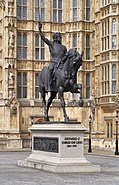
Carlo Marochetti
Baron Pietro Carlo Giovanni Battista Marochetti RA (4 January 1805 – 29 December 1867) was an Italian-born French sculptor belonging to the Sardinian nobility. He worked in France and London and his commissions for Colonial powers, mostly neo-classical sculpture, reliefs, and equestrian monuments in bronze and marble are found around the world. He also made some coloured marble statues.
Life[]
Carlo Marochetti was born in Turin[1] son of Vincenzo, a priest and professor at Turin University, but after the family moved to France, he was brought up in Paris as a French citizen. He studied at the Lycée Napoléon and then studied sculpture at the École des Beaux-Arts in Paris where his teachers were François Joseph Bosio and Antoine-Jean Gros. There his statue of A Young Girl playing with a Dog won a medal in 1829, and his Fallen Angel was exhibited in 1831. Between 1822 and 1830 he studied chiefly in Rome where his mother had settled. While in Rome he collaborated with François-Joseph Duret and Antoine Etex and worked briefly at the studio of Bertel Thorvaldsen. He adopted the neo-classical Romantic school of sculpture. From 1832 to 1848 he lived in Paris, France. He married Camille de Maussion in 1835 and they would have two sons and a daughter.[2] While in Paris he took up commissions for a relief panel of the Battle of Jemappes for the Arc de Triomphe and the Elevation of Mary Magdalene for the altar of the Church of La Madeleine. He rapidly gained fame after this and made several equestrian statues including those of Emanuele Filiberto of Savoy, (Turin) and Ferdinand, duke of Orleans. He followed the French king Louis-Philippe into exile in the United Kingdom after the fall of the July monarchy in 1848. He spent the greater part of his time from then until his death in London. He lived in Onslow Square, and had a large studio, and his own foundry, nearby in Sydney Mews.[3] Among his chief works were statues of Queen Victoria, Colin Campbell, 1st Baron Clyde (erected 1867 in Waterloo Place), and King Richard the Lionheart. The Richard Coeur de Lion (statue) was displayed in the Great Exhibition, and a bronze copy was made in 1860 to be displayed in front of the Palace of Westminster on the orders of Prince Albert. His major commissions were for equestrian monuments and mourning seraphim. Equestrian statues include those of Viscount Combermere in Chester and Sir Mark Cubbon in Bangalore. Monuments with mourning seraphim include those in St. Paul's Cathedral, the Scutari obelisk in Turkey, and the Cawnpore memorial in India.[2]
His statue of Robert Stephenson (installed 1871) still stands in the forecourt of Euston Station. He made a bust of William Makepeace Thackeray for Westminster Abbey. He also created the marble recumbent effigies for the tomb of Queen Victoria and Prince Albert in the Royal Mausoleum at Frogmore in Windsor Great Park and the statue on the Duke of Wellington Commemorative Column outside Stratfield Saye House.
From 1864 he collaborated with Sir Edwin Landseer on the four bronze lions to be placed around the base of Nelson's Column in Trafalgar Square, and cast them at his foundry.[3][4] He experimented in coloured marbles following the work of John Gibson and a coloured statuette of Queen Victoria was exhibited at Bayswater studio but is now lost.[2]
As a favourite sculptor of Queen Victoria, he was commissioned to make the seated figure of Prince Albert for the Albert Memorial in Kensington Gardens. However the first version was rejected by the architect of the monument, Sir George Gilbert Scott, and Marochetti died before a satisfactory second version could be completed.[5] He designed Queen Victoria's memorial to Princess Elizabeth and a bust of Prince Albert at Newport Minster on the Isle of Wight.[6]
Marochetti was created a baron by the King of Sardinia and was also a chevalier of the Legion of Honour. He was elected an associate of the Royal Academy 1861 and a full academician in 1866.[1] Marochetti died in Passy and was buried at the Vaux-sur-Seine cemetery.[2]
Gallery[]
References[]
- ↑ 1.0 1.1 "Baron (Pietro) Carlo Giovanni Battista Marochetti". gla.ac.uk. http://sculpture.gla.ac.uk/view/person.php?id=msib5_1206564902.
- ↑ 2.0 2.1 2.2 2.3 Ward-Jackson, P. (2008). "Marochetti, (Pietro) Carlo Giovanni Battista, Baron Marochetti in the nobility of Sardinia (1805–1867), sculptor". Oxford Dictionary of National Biography. Oxford University Press. Digital object identifier:10.1093/ref:odnb/18085.
- ↑ 3.0 3.1 F. H. W. Sheppard (General Editor) (1983). "The Smith's Charity Estate: Charles James Freake and Onslow Square Gardens". Survey of London: volume 41: Brompton. Institute of Historical Research. http://www.british-history.ac.uk/report.aspx?compid=50012. Retrieved 11 October 2011.
- ↑ http://yourarchives.nationalarchives.gov.uk/index.php?title=Landseer%E2%80%99s_Lions_in_Trafalgar_Square[dead link]
- ↑ "Albert Memorial: The memorial". british-history.ac.uk. http://www.british-history.ac.uk/report.aspx?compid=47524.
- ↑ Page, William (ed.) (1912). "A History of the County of Hampshire: Volume 5. Parishes: Newport". Victoria County History of Hampshire. British History Online. pp. 253–265. http://www.british-history.ac.uk/vch/hants/vol5/pp253-265. Retrieved 3 May 2017.
This article incorporates text from a publication now in the public domain: Chisholm, Hugh, ed. "[[Wikisource:1911 Encyclopædia Britannica/Marochetti, Carlo|]]" Encyclopædia Britannica 17 Cambridge University Press p. 747
External links[]
| Wikimedia Commons has media related to Category:Carlo Marochetti. |
- Historical Images of the marble tomb of the Prince Consort which was built by Marochetti on behalf of Queen Victoria
- Template:FrenchSculptureCensus
The original article can be found at Carlo Marochetti and the edit history here.




